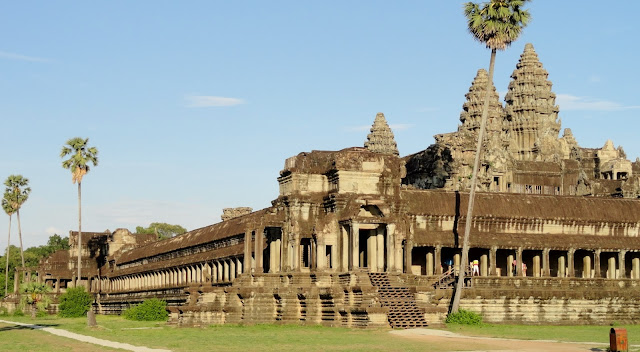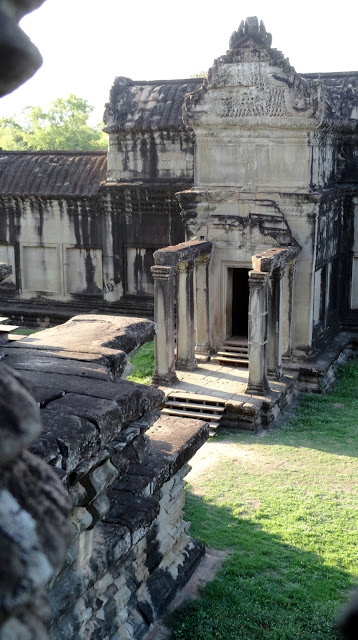After we checked into the hotel, we ate lunch and rested in our room for a while. I had hired a driver/guide and he suggested that we begin our tour of Angkor Wat in the late afternoon on Friday to avoid the worst of the heat. The tour guide's name was Sopheap and he was recommended to me by a friend. We loved him! His English was excellent, he was prompt and his car was clean and in nice condition. He was very knowledgeable about the history of Cambodia, Siem Reap and the sites we were visiting as well as being able to answer our questions about current issues and events.
His name was Sopheap Brem and his contact info is as follows:
Tel: +855(0)12-630 613 or +855(0) 97 975 7799
E-mail :sophiapprem@yahoo.com
About a week before our trip, I sent him an email with the dates we would be in Siem Reap and he responded with an itinerary for me to review and a price. We made a few "on the spot" changes to the itinerary because of the heat and it wasn't a problem at all.
Angkor Wat, (meaning City of Temples), is the largest religious monument in the world. The temple was built by the Khmer King Suryavarman II in the early 12th century in Yasodharapura, which was then the capital of the Khmer Empire and is now present day Angkor. Angkor Wat is one of the better preserved and restored temples in Siem Reap but it is still badly decayed. There are several restoration projects underway at the temple, all sponsored by foreign governments, including those of Germany, Japan and Italy. Angkor Wat is the only temple in Angkor that remained a significant religious center since its construction. Angkor Wat began as a Hindu religious center and then became Buddhist. Angkor Wat is a symbol of Cambodia and, in addition to being the country's prime tourist attraction, it is also featured on the national flag.
His name was Sopheap Brem and his contact info is as follows:
Tel: +855(0)12-630 613 or +855(0) 97 975 7799
E-mail :sophiapprem@yahoo.com
About a week before our trip, I sent him an email with the dates we would be in Siem Reap and he responded with an itinerary for me to review and a price. We made a few "on the spot" changes to the itinerary because of the heat and it wasn't a problem at all.
Angkor Wat, (meaning City of Temples), is the largest religious monument in the world. The temple was built by the Khmer King Suryavarman II in the early 12th century in Yasodharapura, which was then the capital of the Khmer Empire and is now present day Angkor. Angkor Wat is one of the better preserved and restored temples in Siem Reap but it is still badly decayed. There are several restoration projects underway at the temple, all sponsored by foreign governments, including those of Germany, Japan and Italy. Angkor Wat is the only temple in Angkor that remained a significant religious center since its construction. Angkor Wat began as a Hindu religious center and then became Buddhist. Angkor Wat is a symbol of Cambodia and, in addition to being the country's prime tourist attraction, it is also featured on the national flag.
We spent about 2 hours touring the site. To give you an idea of the layout of the temple, I found this aerial photo (photography credits to neta328). The temple is built within a moat (2.2 miles long and 200 meters wide) and an interior wall that surrounds the temple grounds. The interior wall is thought to represent the edge of the world and the moat is the cosmic ocean.


This is an aerial photo of the temple and the grounds inside the moat.

The following are all of my own photos.
Looking over at the temple from across the moat.
Goofballs!

Approaching the main temple area. You can see the area on the right where a large restoration project is currently underway.

This is *the* place to have photos taken as the water reflects all five towers of the temple. Sopheap had obviously done this before because he knew exactly where we had to stand in order to capture all of the towers of the temple and the reflections in our photo.
One of the galleries contained bas-relief panels (intricate stone carvings on the walls - similar to a mural), together over 1,970 feet long which depicted the Battle of Kurukshetra.
Many visitors to the temple have touched this scene and the oil from their fingers has turned the figures brown.
Back at the hotel and on the rooftop for a happy hour celebration.


I enjoyed a glass of French Sauvignon Blanc in honor of the French history in Siem Reap.
Kevin had "Angkor" the national beer.
For dinner, I had the Khmer version of banana blossom salad. Delicious and not spicy (like the Thai's make it).
After dinner, it was off to bed. Sopheap was picking us up at 8:00 the next morning and we had a full schedule for the day!
Have a great Wednesday.

Looking over at the temple from across the moat.

Approaching the main temple area. You can see the area on the right where a large restoration project is currently underway.

This is *the* place to have photos taken as the water reflects all five towers of the temple. Sopheap had obviously done this before because he knew exactly where we had to stand in order to capture all of the towers of the temple and the reflections in our photo.
One of the galleries contained bas-relief panels (intricate stone carvings on the walls - similar to a mural), together over 1,970 feet long which depicted the Battle of Kurukshetra.
Many visitors to the temple have touched this scene and the oil from their fingers has turned the figures brown.
I fell in love with all of the "apsara" figures. Apsaras are beautiful female spirits that represent the clouds and the water in Hindu and Buddhist mythology. Sopheap told us that there are more than 2,000 of these dancing spirits carved into Angkor Wat.
A small section of the ceiling in the temple was painted red. Sopheap said they have been unable to find out why.
Lions at the exit. Back at the hotel and on the rooftop for a happy hour celebration.


I enjoyed a glass of French Sauvignon Blanc in honor of the French history in Siem Reap.
Kevin had "Angkor" the national beer.
For dinner, I had the Khmer version of banana blossom salad. Delicious and not spicy (like the Thai's make it).
After dinner, it was off to bed. Sopheap was picking us up at 8:00 the next morning and we had a full schedule for the day!
Have a great Wednesday.








































































No comments:
Post a Comment